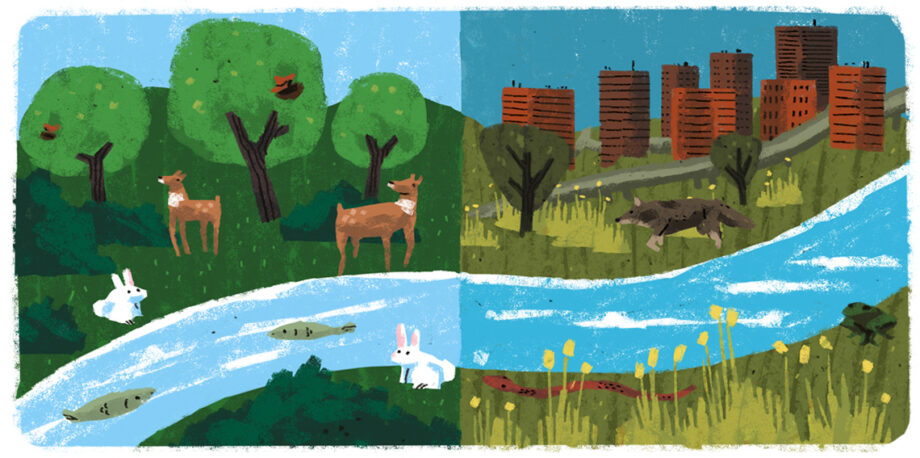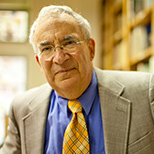January 21, 2015 — Conservation biology and restoration ecology have been roiled by a bandwagon termed “novel ecosystems,” heralded as the “new ecological world order” in a manifesto published in 2006 by several ecologists headed by Richard Hobbs, then editor in chief of the journal Restoration Ecology. The claim is that human influences — especially introduced invasive species, land use changes and global climate change — are altering a large proportion of Earth’s ecosystems at unprecedented rates in a way that could cause assemblages of organisms to “tip” towards new steady states, which should be considered as emerging or, to use the catchier phrase, “novel” ecosystems.
Hobbs and colleagues argued that attempting to restore such ecosystems to some semblance of a pristine or pre-disturbance condition is a futile waste of resources. Rather, in their view, restoration ecologists should strive to manage the resulting “novel ecosystems” to maximize services they provide to human populations, such as flood control, carbon sequestration and pollination. This message was taken further in 2010, when journalist Emma Marris proclaimed novel ecosystems the “new normal” and urged scientists and the public to embrace them and rejoice in the things they can do for us. Marris and Hobbs alike suggested that anyone who doesn’t jump on this bandwagon and instead persists in “classical” restoration or conservation is struggling to work through the first stage of grief (shock and denial) after a major loss — in this case, the irreversible loss of biodiversity.
Though recently both have softened their positions somewhat, the damage has been done. Several scientific papers in some of the most influential journals jumped on the bandwagon, and people started to swallow the whole notion without the benefit of evidence or at least proof of concept and use it without further consideration of what it really means. So we think it is important to ask a few fundamental questions to make sure we are not going astray.
First, though, we must define just what a novel ecosystem is, because definitions have been vague and variable. In 2013 Hobbs and co-authors defined a novel ecosystem as “a system of abiotic, biotic, and social components (and their interactions) that, by virtue of human influence, differ from those that prevailed historically, having a tendency to self-organize and manifest novel qualities without intensive human management.” This is basically a definition of an ecosystem (a self-organizing system with biotic and abiotic components) but with a twist: The combination of elements that compose it must be new and caused by humans, and that novelty needs to persist without further human intervention. The problem is, manmade ecosystems that differ from anything historically and provide ecosystem services, such as farms, are not self-organizing, typically depend on many subsidies and do not persist without them.
Are restoration ecologists hopelessly mired in an attempt to re-create an unattainable prelapsarian Eden? Hardly.
In fact, not a single novel ecosystem by this definition has yet been identified. The graphs in the scientific literature all lack numbers on their axes, so it is unclear at what point in terms of anthropogenic disturbance and biotic novelty an ecosystem might qualify as novel. Also, no evidence has been presented that any candidate system tends to self-organize and would persist without humans. Worse, even this definition’s authors do not see a way to make it operational. In a 2009 paper they write, “the distinction between [novel and historic] is somewhat arbitrary, and the exact point at which an ecosystem is considered novel cannot necessarily be universally applied” and “all ecosystems can be considered ‘novel’ when placed in the appropriate temporal context.”
So, are restoration ecologists hopelessly mired in an attempt to re-create an unattainable prelapsarian Eden? Hardly. Restoration ecologists long ago abandoned the idea that nature is static and that any ecosystem would remain unchanged even if humans were not part of the picture. Nowadays, the goal of ecological restoration is to re-establish as closely as possible the historical trajectories of ecosystems before human actions drastically changed them, so that the restored ecosystems can continue to respond to environmental changes as these arise.
Have restoration ecologists somehow been fooled into thinking that ecological restoration is actually worthwhile and necessary to achieve their goals of reversing land degradation? Three decades of results show that, although sometimes expensive, ecological restoration is possible. But can novel ecosystems do better? Can we get novel ecosystems to perform the services we need? And, if they do, is that good enough for conservation purposes? Importantly, even if we could identify novel ecosystems and they provided services for human populations, that would not mean they would also maintain many of the rare and threatened species we are struggling to save. The ecosystem services that humans want are not necessarily those required by a vast swath of biodiversity.
The argument that attempting to restore an ecosystem is futile — despite the fact that it is demonstrably often wrong — and that novel ecosystems can serve our purposes better can only lead policy-makers to be more willing to allow environmentally damaging projects.
Deficiencies in definition and loose verbiage about stable, service-providing novel ecosystems and the futility of “traditional” restoration can serve as a Trojan horse to biodiversity conservation. Without evidence of self-organization and persistence, not to mention of provision of ecosystem services, the novel-ecosystem label can serve as a Get Out of Jail Free card for companies or individuals trying to avoid investing in research, mitigation or restoration by claiming they are producing novel ecosystems that will provide ecosystem services. In Colombia, for instance, a sugarcane grower who had clear-cut forest right to the edge of rivers, thus violating a law, defended the practice on the grounds that the scientists developing the novel-ecosystem concept advocate seeking a new ecosystem, even one with introduced species, rather than restoring the damaged system, so long as the new ecosystem provides a service. This statement, in turn, led other landowners to boycott a government-driven project to restore riparian forest along the Cauca River. The arguments that attempting to restore an ecosystem is futile — despite the fact that it is demonstrably often wrong — and that novel ecosystems can serve our purposes better can only lead policy-makers to be more willing to allow environmentally damaging projects and the public to exert less pressure to prevent habitat destruction.
This rhetoric is quite damaging, considering that various national and international agencies and treaties, including the European Commission and the United Nations’ Convention on Biological Diversity and Convention to Combat Desertification, have called for increasing restoration efforts, and major non-governmental organizations — such as the International Union for Conservation of Nature, The Nature Conservancy, World Resources Institute and World Wide Fund for Nature — have advocated large-scale restoration as part of their global programs to redress the loss of biodiversity and decline of natural ecosystems. More specifically, in 2011 the German government and IUCN challenged the world’s nations to restore 150 million hectares of deforested and degraded lands by 2020. Brazil intends to restore 15 million hectares, and seven Latin American countries have pledged to restore 20 million more. Are all these countries and international institutions out of touch with reality or misguided by sentimental scientists?
Again, hardly. In fact, at the end of 2014 Hobbs and colleagues in a scientific article, and Marris and a conservation NGO leader in an op-ed, took a starkly more ecumenical line, saying that traditional restoration can play a role alongside novel ecosystems in the new ecological world order they claim is upon us.
It remains to be seen how this new attitude will play out in terms of preserving or recovering the nonanthropogenic ecosystems upon which so much of biodiversity, including many of the most imperiled species, critically depends. One can only hope that it will shift the balance in favor of respecting — and, as appropriate, restoring — these ecosystems before it’s too late.
![]()
Editor’s note: The views expressed here are those of the author and not necessarily of Ensia. We present them to further discussion around important topics. We encourage you to respond with a comment below, following our commenting guidelines, which can be found here. In addition, you might consider submitting a Voices piece of your own. See Ensia’s “Contact” page for submission guidelines.
Ensia shares solutions-focused stories free of charge through our online magazine and partner media. That means audiences around the world have ready access to stories that can — and do — help them shape a better future. If you value our work, please show your support today.
Yes, I'll support Ensia!



We are being told by the "novels" that the emperor (i.e. the Earth) has new clothes: that novel ecosystems are the new order. Defenders of natural ecosystems and ecological restoration need to say, loudly, that, the novels have nothing on at all, until proven proven otherwise.
Herbicides are used by virtually all land managers to control plants they consider “invasive.” In a survey done by the California Invasive Plant Council, 62% of land managers report using herbicides “frequently” and 10% use them “always.” Only 6% of land managers say they do not use herbicides. Herbicides are killing microbes and fungi in the soil. Herbicides that are mobile in the soil are killing plants that are not the intended targets. Undoubtedly, there is more damage to plants and animals (including humans) about which nothing is yet known. Surely it is a factor in the stunning lack of success of most “restorations.”
Prescribed burns are also used to destroy non-native plants as well as native plants which naturally succeed grassland in the absence of fire. Prescribed burns pollute our air and endanger our lives and properties. Many prescribed burns have caused wildfires. Every prescribed burn risks more wildfires in our increasingly hot, dry climate.
Biological controls used to destroy non-native plants are also a crap shoot. Fifteen species of native moths on Hawaii are now extinct as the result of a biological control gone bad.
“Restoration” projects are destroying the habitat of animals, in many cases native animals and in some cases endangered animals. Non-native spartina eradication has caused the population of endangered Clapper Rail (now Ridgeway Rail) to plummet. The eradication of eucalyptus is depriving the migrating population of monarchs of their winter roost. Studies report that 75% of migrating monarchs in California were roosting in eucalyptus when the study was done.
Millions of trees are being destroyed in California (and elsewhere) because they are non-native or because they are “invading” grassland or scrub, which is the preferred vegetation by nativists. These trees store many millions of tons of carbon which is released into the atmosphere as carbon dioxide when the trees are destroyed and decay on the ground. Invasion biology is therefore contributing to the greenhouse gases that are the cause of climate change. Ultimately climate change will render the concept of “native” meaningless.
As long as invasion biologists refuse to acknowledge the damage being done by the projects they demand, their defense is fundamentally dishonest. I, for one, do not find any merit in their arguments until they propose a method of “restoring” native ecosystems without damaging the environment. Until they do, it is fair to say that these projects are doing far more harm than good.
People love to hate eucalyptus, solely for the sin of being non-native. The eucalyptus forest is different from the Mediterranean annual grasses that existed in the same locations before the trees were planted—so the forests must be destroyed. There is strong, organized political pressure to “restore” these forests to . . . Well, to what? Now we get into the truly “hypothetical.” Stated goals include native grassland (which was gone long before the eucs arrived), “native forest” (when no forest at all existed in these locations prior to eucalyptus), grassland and dune scrub (which is seldom stated explicitly because the public prefers trees), etc. Methods are equally unfocused: sometimes replanting is planned. Sometimes it is claimed that removing the eucs and poisoning their stumps is all that is necessary; native plants will recolonize on their own. So far, the only results are expanded opportunities for broom, anise, yellow star thistle, hemlock, etc, all of which move quickly into the disturbed areas.
For me, the “novel ecosystem” moniker is a very useful way to reframe areas (and the Earth is covered with them, despite what the authors say) that have traditionally been designated as “degraded,” “abandoned,” “trashed,” “ruined” and similar terms heavy with disapprobation. The central claim of the novel ecosystem framework is that such places still have conservation value, even if the prospect of restoring them to their historical trajectories is very dim. They can be surprisingly diverse, even if many of the species are in the “wrong” place; they can sequester carbon and cycle nutrients just as historically “correct” ecosystems can. They can provide habitat for native species. And so on.
We can see value, even beauty, in unfamiliar configurations of flora and fauna, and protect them, rather than just abandoning them to mindless development.
If the risk of embracing novel ecosystems is that they will encourage degradation of "intact" systems (and I doubt this will be widespread, given the obvious and widely-shared value placed on such ecosystems); the risk of not embracing novel ecosystems is that they will all be turned into parking lots because they are just "weed patches".
Aside from this, while the concept of Novel Ecosystem may be interpreted as sinister, it might also be necessary. As well, many people, such as myself, promote diversity through interaction. An ecosystem which is self-sustaining, and generates novel INTERACTIONS, is agreeable. There is a difference.
Why not try to clean up after ourselves? If we can do something about it why not try. Why not try to rehabilitate the amazon, and diminish invasive species. Why not try to assist ecosystems in interacting, therefore promoting diversity by facilitating proper environments. Why not try to save the oceans, or the lakes, or the wetlands? Wetlands are all but destroyed, and conservation isn't going to do anything about helping them recover. As long as pollutants and invasive species prevent that from happening. Restoration Ecology offers great promise in prevent total collapse. Why not, because someone thinks its a bad idea? As opposed to what?
Now it is"integrity" that can be achieved or lost and it seems that one species, Homo sapiens for probably some circular reasoning is excluded to have an influence. If a bird drops a treeseed in a place that never had seen this tree, most likely the integrity is not lost. When a human does the same thing, it is. if both mean integrity is lost it implies that restoration ecologists (or at least Simberloff and co.) stand for a extremely static nature.
Btw: climate has changed a lot. In many coastal areas of northwestern Europe we she a sharp rise in precipitation and a continuous rise in temperature. So the ecoystems that still grow there do not grow in the place where they climatologivall should. Is it now a novel ecosystem. Can it remain unchanged when the temperature rises 2K, 3k..5K. You know CO2 levels won't magically stop at the much touted 2* CO2 levels. That is just some point in time to indicate what a doubling of CO2 means for global temperatures.
Novel ecosystems clearly are the norm when we say that any human influence that changes the composition of some place constitutes such a system.
Another piont: are people also right when they say that some foreigner from another culture or religion enters a country where this did not exist before, jeopardises the integrity of that culture? Should we therefor get rid of this person?
Because ecologists are the first ones who reject the notion of a clear resemblance with humans who want to keep their countries "integrity" intact....
Restotoration ecology, conservation ecology to my mind are simply extremely conservative views on the natural world. Any change is deemed bad, any human influence (bar their own) meets valueladen terms. Any newcoming species is per definition unwanted and if it does too well somewhere, it needs to be eradicated.
Now some ecologists have a different view on novel ecosystems and "the damage is done". Because some people hijack the term for personal benefit. Which is another trait of politics rather than science: examples are used to support some claims. Well, the fact that some people abuse the intention of scientists does not mean that this is the general result of their writing.
The importance of biodiversity has been hijacked by some local environmentalists too: the Red Squirrel is not an endangered species at all, it is extirpated in the UK and could become extinct on the British Isles. Yet based on "biodiversity" millions and millions of pounds are put into projects for the futile eradication of their grey cousins. Money that should be spent on truely endangered species that do not live on Britain, but in Indonesia for instance. Are Simberloff and co. somehow the culprit here for others hijacking their intentions with Biodiversity (meant on global and not local scale) by these groups? I think not. Nor are those who advocate the acceptance of novel systems the ones who have caused damage when someone hijacks their stance here for personal gain.
Simberloff, Murcia Aranson and many others remind me a whole lot of Climate Change deniers: they present very little evidence for their absurd claims on immigrants. They tend to be very vocal with extreme claims in the media. And their basis is a pseudoscience that perpetuates itself by indoctinating the next wave of students with books in the University that indoctrinate them with valueladen in strad of neutral wording. With opinions built into them and by not letting students form their own opinions, gather data in an unbiased way and forcing them to let laypeople, politicians etc to form their OWN opinion based on the truely scientific data.
Novel ecosystems are a fact of life, regardless of their exact description. Change is a fact on this planet and it is a fact that very rapid significant change is now ongoing without any sign of slowing down, let alone reversal. It seems acceptance is the key word here.
Thank you for your incisive analysis of the ideology of “invasion biology,” which is destructive at its core.
In the UK there is now a very popular and growing move to promote 'feral' nature but this is not presented with any understanding of underpinning science or indeed of the real-time consequences of invasion biology and 'abandonment'. When supposedly 'feral' communities are in practice the result of abandonment the result can be what I describe as a 'neoliberal market ecology' -i.e. the survival of the fittest. Rob Marrs has described this as the release of the 'ecological thugs'.
My view is that recombinant and hybrid ecologies are a reality but our decisions on the ecosystems that we wish to maintain or conserve, need to be informed by hard science and knowledge of history - and we need to address issues of perceptions, of politics, and of course, money. Novel ecologies and hybrid ecosystems (and increasingly, hybrid species) are happening across Britain and Europe certainly, and in some cases are inevitable and result in interesting and distinctive systems. However, this should not be a reason to abandon traditional nature conservation but a spur to get conservation right - in Sir John Lawton's words - bigger, better, bolder and more joined. Also, whilst many are now advocating feral ecologies as a low-cost or even free solution to all of nature's problems - forget it, we need to be prepared to pay and the reality is that if we do not, then the cost will be event greater.
1) Rotherham, I.D. (2017) Recombinant Ecology – a hybrid future? Springer Briefs, Springer, Dordrecht.
2) Rotherham, I.D. (2016) Eco-fusion of alien and native as a new conceptual framework for historical ecology. In: Vaz, E., de Melo, C.J., & Pinto, L. (eds) Environmental history in the making. Volume1, Springer, Dordrecht, The Netherlands
3) Rotherham, I.D. & Lambert, R.A. (eds.) (2011) Invasive and Introduced Plants and Animals: Human Perceptions, Attitudes and Approaches to Management. EARTHSCAN, London.